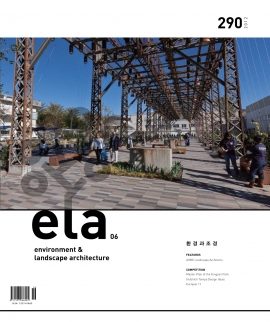마샤 슈왈츠
Q. Bagel Garden, Necco Garden, Rio Shopping Center 등 당신의 초기의 작품들을 보면 기하학적인 선과 반복되는 패턴들, 그리고 팝 아트에 영향을 받은 듯한 유머와 아이러니가 등장한다. 또한 미니멀리즘의 영향도 강하게 보인다. 이러한 기하학적 패턴과 아이러니, 그리고 미니멀리즘이 당신의 작품에 등장하게 된 까닭이 무엇인지 궁금하다.
A. 나는 어릴 때부터 기하학적인 문양에 관심이 많았다. 내가 학생 때 했던 미술작품들의 스케치에도 기하학적 요소가 보인다는 말을 종종 듣곤 했다. 기하학적인 문양은 각 지역의 문화에 따라 서로 다른 상징과 일종의 신비함을 가지고 있어서 더욱 관심이 많았던 것 같다. 내 작품에 보이는 팝아트의 요소에 대해 말하자면, 나는 앤디 워홀이 한창 전성기일 때와 같은 젊은 시절을 공유했다. 내 베이글 가든은 어떤 면에서 앤디 워홀의 브릴로 상자(Brillo Boxes)들과 비슷하다. 앤디워홀의 브릴로 상자들이 전시장에 있는 것 자체가 아이러니한 것처럼, 베이글이 정원의 요소가 된다는 것이 얼마나 아이러니한가? 조경의 언어가 미술의 언어를 공유한 것이라고나 할까? 또한 나는 미니멀리즘이 전성기일 때를 공유한 세대로서, 미니멀리즘이 조경에 미친 영향에 대해 항상 긍정적으로 생각한다. 가장 적은 재료로 가장 강력한 개념을 창출한 미니멀리즘 작가들의 힘은 조경 작품을 만드는데매우 의미 있는 선례가 된다.
사실 미술이 변화하는 세상을 가장 잘 반영하는 장르인 것은 미술이 새로운 개념을 수용하고 보여주는데 매우 자유롭기 때문이다. 때문에 나는 현대미술에 여전히 관심이 많다. 또한 나는 현대 미술이 기초하는 대중문화 역시 관심이 많다. 조경가들은 현재 벌어지는 재미난 문화현상들에 대해 항상 열려 있어야한다고 생각한다.
Q. These days, the scope and scale of your projects produced in MSP are extremely diverse ranging from small urban gardens to regional urban projects. You initially gained publicity in design circles for your small-scaled, very playful provisional landscape installations such as Bagel Garden or Splice Garden. Today you are working on large-scale, ‘permanent’ landscapes such as a master planning of Doha Corniche at Qatar. How these transition has occurred?
A. When I came into the profession I didn’t know anything about landscape architecture. I came in from art world. I had a slightly different agenda than most people in the landscape architecture does. I wanted to make a landscape-scaled art. When I started early off, I started making art installations which were basically a manifesto. I could see how limited and boring it was the profession of landscape architecture in thirty years ago: it was very serious, corporate, male-oriented world. There were even ‘appropriate’ landscapes and ‘inappropriate’ landscapes. So, when I did a Bagel Garden, it was such a big controversy; people were outraged!
My point of that piece was about, ‘who says the landscape has to be a certain way?’ People often have a very romanic view on how the landscape should be. But in urban condition, we make a landscape on a super-structure, like building landscapes on a tanker. Hence, as long as we're building our landscape, it can be anything. Why are there such cultural restrictions about what can happen in the landscape? the problem is that desire also keeps us back from seeing the landscape as ‘what has become’, which is built, designed, determined environment that humans increasingly have to live in. It's not nature.
I found it more interesting that people flicked out and it caused such a tectonic shift in a profession. I kept doing these small installations. I didn't have any client. They were very ‘unprofessional’ works. But I did them as an artist. I believed that I could change the world in a very small space because of my strong concept. It doesn't make less important than permeant gardens just because my little garden last in two days. So, it's all about the quality of thought. That's a power of artists.
My work has expended very slowly. Now we work with city. But I haven’t lost my desire to make something unique. Everytime our team visit sites we try to make something very special for that site. We try not to duplicate what we’ve done before. We also work in a way that the client, users, and people have a voice where we use the design process to find out what people like. We're flexible in terms of coming up with ideas.
The world is changing so much. Since the time I was born the population have been tippled. I’ve been really questioning about how the design actually do for this changing circumstance. That’s the question that the designers have to be able to answer: what value are we providing? Does design really matter? If it does, how do we articulate our value? These are very interesting questions because we have to substantiate how the landscape will make a better city. Unlike many environmentalist who make economic equations to convince people, we need to make longer equations see if the people and city would work in much longer term. We have to all be better trying to explain our value of the landscape in the built environment and what we do affect to the issue of sustainability. That's what I am trying to do now.





